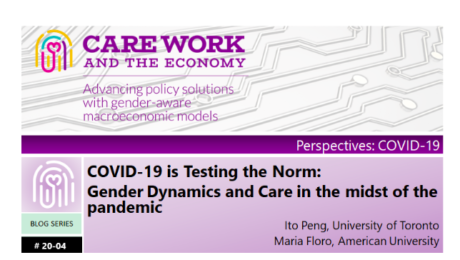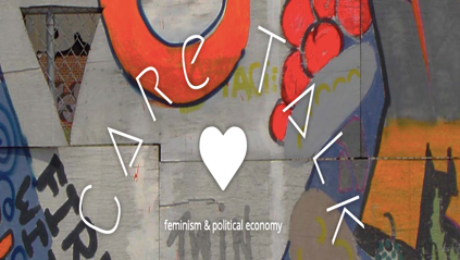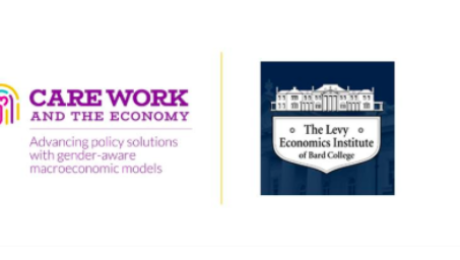COVID-19 is Testing the Norm: Gender Dynamics and Care in the Midst of the Pandemic
The COVID-19 crisis has upended lives around the world. It has forced cities and countries to enforce lockdown and social distancing regulations. Schools and businesses are closed and people are told to self-isolate, stay home, telework (if your job allows), to not go out except to get essential things, and care for each other but in distance. For those who live on their own, COVID-19 is about learning to live with solitude and loneliness, except for the occasional video, online or phone chats. For others who are living in a family, it is about living together in a confined space, 24/7, balancing work and family responsibilities, and rearranging the share of housework. The COVID-19 crisis is not just leaving a trail of human and economic sufferings; it is also testing prevailing gender norms as it confines both paid and unpaid work activities for many households within the same space.
Amongst the many lessons that the COVID-19 pandemic is teaching us, one of the most important is the centrality of care in maintaining a healthy, balanced and functional society and economy. Additionally, how much of that care is implanted in and shaped by our social and cultural norms. These norms vary by culture, class, caste, ethnicity, religion, and life cycle stage. Before the COVID-19, most of us had regular normal lives: during week days, children went to schools and adults either went to work or were looking for work. Frail elderly and disabled people were given necessary care by family members, relatives, domestic/ personal service workers or care service institutions. During weekends and holidays, social, religious, cultural, and leisure activities alongside weekend domestic chores filled people’s time.
But that was before the COVID-19; it is not the same anymore. The stay-at-home, social distancing and travel restrictions have forced household members to be physically together day and night. Without the vital and often taken-for-granted services such as daycares, after school programs, and community centre activities, and without opportunities to engage in social activities with other people, many households are suddenly faced with the challenges of having to both doing market work and care for their children as well as the sick, disabled, and frail elderly member needing care. It seems that the lived experiences of informal home-based women workers are now shared by millions around the world who have dependents: the constant juggling of different demands on one’s time and the stress of having to frequently multi-task. On one hand, there is the increased level of unpaid work that needs to be done, and on the other, the necessity to earn one’s livelihood from home. Many households therefore are faced with – for the first time – the imperatives of having to share the heavy burden of unpaid work. Will it be the usual division of household work as in ordinary “normal” times? Or will the situation at hand involve new negotiations and allow some upending of gender roles?
In unexpected ways, the COVID-19 health crisis has opened windows for women and men to see and experience the other “gender” role up close and personal: those not in the labor force see and hear the day-to-day business of earning a living ala “online”, while the “breadwinners” see and hear children needing attention, help with schoolwork, crying in the background, etc. In some households, men are now more willing to take on more care work, do the laundry, clean house and cook some meals. But in other households, the current situation may intensify existing unequal gender relations and heighten tensions. Male household heads for example, may deliberately utilize traditional gender norms to maintain discipline and control. For example, women are expected to find ways of combining childcare and market work by multi-tasking or lengthening their workday in order to reduce to the minimum any distraction or job interruptions to the head. In other cases, the angst associated with no social contacts or support, employment-related anxiety and growing economic insecurity may lead to increased drinking, rising tensions and even domestic violence. Fearful of the loss of their masculine identity, men may reinforce women’s submission to patriarchal rules in the household. Unfortunately, the situation created by the COVID-19 limits the options for women to seek help when they face threats to violence or are victims.
As social norms continue to evolve and traditional gender roles within households are tested in varied ways, one thing is clear: the COVID-19 crisis is exposing, and disrupting, the core system that supports our society and underpins our economy – the mixed economy of care. In ordinary or “normal” times, our lives are made manageable and our economy sustainable because different social institutions are providing different kinds of care in both paid and unpaid forms. These include public and private institutions, such as schools, hospitals, community centers and other social and community services providing essential health, education, and other social services; within the household (mainly women) doing unpaid essential care and domestic work. We take for granted this care delivery system, especially those institutional arrangements involving unpaid labour. We forget that care collectively provided by all these institutions play an important role in supporting us socially and economically. The COVID-19 crisis is teaching us that we are all socially and economically interdependent: we all give and receive care throughout our lives, and that we must recognize, understand and find ways to ensure that care work is valued. It is also giving us the opportunity to reflect on how the responsibility for and the cost of providing care can be better shared within households as well as within society – and on how we might better restructure our mixed economy of care.
This blog was authored by Ito Peng and Maria Floro
- Published in COVID 19, Gender Inequalities
Are We All Care Workers Now?
Who, exactly, are care workers, other than the people we need most right now, as the covid-19 pandemic overlays the division of labor with a new division of risk?
I’ve long been an advocate of using the term “care worker” rather than “caregiver” even though the work can be and often is, at least in part, a gift. Because care–whether performed for pay, or not–is at the crux of any sustainable economic system. All work depends on the successful production and maintenance of workers themselves. Yet because this very notion of care-as-work is relatively new, there is little agreement on its exact boundaries.
When I first started pursuing this issue with Paula England, we emphasized hands-on or face-to-face work that develops the capabilities of the care recipient, an essential aspect of the services that health care providers, workers, child care and elder care workers provide. This emphasis could be translated into a specific list of Census-designated occupations, grounding empirical research on the relative pay of care workers that has revealed significant pay penalties for both women and men in such occupations, controlling for many other variables such as education, experience, and unionization.
I liked this broad definition because it spanned paid and unpaid work, low-wage and relatively high-wage occupations, women and men, creating potential for new political alliances. Sociologists initially embraced the definition with some enthusiasm. Not so, economists, and Robert Solow, who attended some meetings of the Russell Sage Foundation Network on Care Work, pushed us for more specificity.
I felt some affinity with Kenneth Arrow’s insistence on the limits of markets and with efficiency-wage theories pointing to the difficulty of monitoring worker productivity, so added another twist to the definition: work in which concern for the welfare of the care recipient is likely to affect the quality of the service provided. In other words, work not performed entirely for money, akin to what some economists have termed “public service motivation” but more…personal.
Still not quite right. Sociologist Mignon Duffy has argued eloquently in Making Care Count that this definition privileges what she calls “nurturant care,” deflecting attention from the drudgery of menial care tasks–the emptying of bed pans, cleaning of toilets, and mopping of floors often performed by the most disempowered members of society. “Dirty” work itself is devalued. Duffy’s work has nudged me to focus more on industry–the economic consequences, for instance, of being employed in health care, education, or social services, regardless of occupation.
The pandemic, however, has pushed me over a cliff, because it is redefining the meaning of “dirty” work–now, any work that increases the risk of exposure to a potentially deadly virus: not just health care, child care, and elder care and unpaid care for family members, but also food services, package delivery, police protection, home repair services, garbage collection…the list goes on. We rely heavily on the motivations of such workers to minimize our own–as well as their own–chances of infection.
The entire sequestration/shelter-in-place/social distancing strategy relies heavily on good will and voluntary compliance. The very invisibility of covid-19 blurs the boundaries between love and money, us and them. The healthy now may later be sick, the sick now may later be dead. When risk is shared, the overlaps between solidarity and self-interest expand.
Yet so many boundaries, however blurry, remain in place. Whether because of who they are or what they do, some workers face much greater risks than others. It’s not enough to cheer them on, to offer them applause or a bit of extra cash.
If we are all care workers now we should do everything in our power to protect our own.
Original blog published on CARE TALK: FEMINIST AND POLITICAL ECONOMY on April 4, 2020. See https://blogs.umass.edu/folbre/
Reposted with permission from Dr. Nancy Folbre from University of Massechusetts Amherst and an expert researcher for the Care Work and the Economy Project
- Published in Child Care, COVID 19, elderly care



